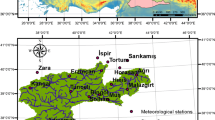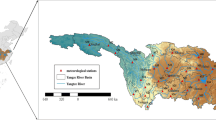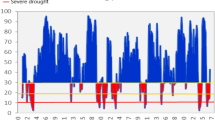Abstract
Drought indices are commonly used to monitor the duration and severity of droughts. In this regard, the continuously changing climate regardless of its cause or effect pushes the limit of the water deficit through time and space. Izmir is a raising city in Turkey, which owns various water resources including but not limited to seashores, lakes, river streams, and groundwater aquifers. In this study, the long-term precipitation and temperature records from 14 meteorological stations between 1973 and 2020 (for 47 years) are used to investigate the drought characteristics in Buyuk Menderes, Kucuk Menderes, and Gediz basins located in the Aegean region of Turkey. For this, the Standardized Precipitation Index (SPI) and the Standardized Precipitation Evapotranspiration Index (SPEI), Percent of Normal (PNI), and the so-called Discrepancy Precipitation Index (DPI) are used with consideration to 1-, 3-, 6-, and 12-month moving averages to investigate the drought patterns. Results showed that the monthly indices depict very similar results for the entire region. However, in the 1980s and 2010s droughts were more severe than the rest of the historical records. When the moving average operator is implemented in the analysis (3-, 6- and 12-month periods), neither SPI nor the SPEI showed the same results at any stations. It is illustrated that the periods of severe and normal drought have occurred in the past, yet the indices that are obtained using average values are generally within the normal limits, but extreme values (extremely arid or extremely wet) occurred occasionally. It is also concluded that although there is a similarity between the implemented indices, the DPI and PNI depict the highest resemblance.













Similar content being viewed by others
Data Availability
The datasets used and/or analyzed during the current study are available from the corresponding author on reasonable request.
Code Availability
None.
References
Azmi, M., Rudiger, C., & Walker, J. P. (2016). A data fusion-based drought index. Water Resources Research, 52(3), 2222–2239.
Amirataee, B., & Montaseri, M. (2016). The performance of SPI AND PNPI in analyzing the spatial and temporal trend of dry and wet periods over Iran. Natural Hazards, 86(1), 89–106. https://doi.org/10.1007/s11069-016-2675-4
Bari Abarghouei, H., Asadi Zarch, M. A., Dastorani, M. T., Kousari, M. R., & Safari Zarch, M. (2011). The survey of CLIMATIC Drought trend in Iran. Stochastic Environmental Research and Risk Assessment, 25(6), 851–863. https://doi.org/10.1007/s00477-011-0491-7
Barua, S., Ng, A., & Perera, B. (2010). Comparative evaluation of drought indexes: A case study on the Yarra River catchment in Australia. Journal of Water Resources Planning and Management, 137, 215–226.
Danandeh Mehr, A., Safari, M. J. S., & Nourani, V. (2021). Wavelet packet-genetic programming: A new model for meteorological drought hindcasting. Teknik Dergi, 32(4), 11029–11050.
Danandeh Mehr, A., & Vaheddoost, B. (2020). Identification of the trends associated with the SPI and SPEI indices across Ankara, Turkey. Theoretical and Applied Climatology, 139(3), 1531–1542. https://doi.org/10.1007/s00704-019-03071-9
Eslamian, S. (Ed.). (2014). Handbook of engineering hydrology: Modeling, climate change, and variability (1st ed.). CRC Press.
Guner Bacanli, U. (2017). Trend analysis of precipitation and drought in the Aegean region. Turkey. Meteorological Applications, 24(2), 239–249.
Kendall, M. G. (1975). Rank correlation methods (4th ed.). Charles Griffin.
Liu, X., Zhu, X., Zhang, Q., Yang, T., Pan, Y., & Sun, P. (2020). Remote sensing and artificial neural network-based integrated agricultural drought index: Index development and applications. CATENA, 186, 104394.
McKee, T. B., Doesken, N. J., Kleist, J. (1993). The relationship of drought frequency and duration to time scales. In Proceedings of the 8th conference on applied climatology (Vol. 17, No. 22, pp. 179–183). American Meteorological Society
Mann, H. B. (1945). Nonparametric tests against trend. Econometrica Journal of the Econometric Society. https://doi.org/10.2307/1907187
Mehdizadeh, S., Ahmadi, F., Danandeh Mehr, A., & Safari, M. J. S. (2020). Drought modeling using classic time series and hybrid wavelet-gene expression programming models. Journal of Hydrology, 587, 125017.
Mirabbasi Najaf Abadi, R., Ahmadi, F., Ashuri, M., & Nazeri Tahroudi, M. (2017). Droughts analysis in the Northeast of Iran using Joint Deficit Index (JDI). Iranian Journal of Ecohydrology, 4(2), 573–585.
Morid, S., Smakhtin, V., & Moghaddasi, M. (2006). Comparison of seven meteorological indices for drought monitoring in Iran. International Journal of Climatology, 26(7), 971–985. https://doi.org/10.1002/joc.1264.
Pamuk, G., Ozgurel, M., & Topcuoglu, K. (2004). Standart yagıs indisi (SPI) ile Ege bolgesinde kuraklık analizi. Ege Universitesi Ziraat Fakultesi Dergisi, 41(1)
Reddy, P. J. R. (2006). A Textbook of Hydrology. Laxmi Publications.
Sheffield, J., & Wood, E. F. (2012). Drought: Past problems and future scenarios. Routledge.
Sirdas, S., & Sen, Z. (2010). Meteorolojik kuraklık modellemesi ve Turkiye uygulaması. İTUDERGİSİ/d, 2(2).
Sokollu, S. (2014). Turkey battles water shortage. Deutsche Welle (DW). https://p.dw.com/p/1BFcf
Svoboda, M., & Fuchs, B. (2016). Handbook of drought indicators and indices. World Meteorological Organization (WMO). WMO-No. 1173
Svoboda, M., LeComte, D., Hayes, M., Heim, R., Gleason, K., Angel, J., et al. (2002). The drought monitors. Bulletin of the American Meteorological Society, 83(8), 1181–1190.
Tayfur, G. (2020). Spatial and temporal variation of meteorological drought and precipitation trend analysis over whole Mauritania. Journal of African Earth Sciences. https://doi.org/10.1016/j.jafrearsci.2020.103761
Tayfur, G. (2021). Discrepancy precipitation index for monitoring meteorological drought. Journal of Hydrology. https://doi.org/10.1016/j.jhydrol.2021.126174
Temeliyeh, K., Rezaei, H., & Mirabbasi Najafabadi, R. (2020). Multivariate analysis of meteorological droughts in Iran using joint deficit index (JDI). Journal of Agricultural Meteorology, 8(1), 26–39.
Terzi, S., Torresan, S., Schneiderbauer, S., Critto, A., Zebisch, M., & Marcomini, A. (2019). Multi-risk assessment in mountain regions: A review of modeling approaches for climate change adaptation. Journal of Environmental Management, 232, 759–771. https://doi.org/10.1016/j.jenvman.2018.11.100
Topcuoglu, K., Ozgurel, M., & Pamuk, G. (2004). Turkiye icin yeni bir kuraklık indisi denemesi. Ege Universitesi Ziraat Fakultesi Dergisi, 41(3).
Tsakiris, G., Pangalou, D., & Vangelis, H. (2007). Regional drought assessment based on the Reconnaissance Drought Index (RDI). Water Resources Management, 21(5), 821–833.
Umran Komuscu, A. (1999). Using the SPI to analyze spatial and temporal patterns of drought in Turkey. Drought Network News, 1994–2001, 49.
Vaheddoost, B., & Safari, M. J. S. (2021). Application of signal processing in tracking meteorological drought in a mountainous region. Pure and Applied Geophysics, 178(5), 1943–1957.
Wilhite, D. A. (2005). Drought and water crises: Science, technology, and management issues. CRC Press.
Wilhite, D. A. (2009). The role of monitoring as a component of preparedness planning: Delivery of information and decision support tools. Coping with drought risk in agriculture and water supply systems: Drought management and policy development in the Mediterranean. Springer.
Wilhite, D. A., & Glantz, M. H. (1985). Understanding: The drought phenomenon: The role of definitions. Water International, 10(3), 111–120.
World Meteorological Organization (WMO). (2011). Proceedings of an Expert Meeting 2–4 June 2010, Murcia, Spain
World Meteorological Organization (WMO). (2012). Standardized precipitation index user guide. Geneva
Yacoub, E., & Tayfur, G. (2017). Evaluation and assessment of meteorological drought by different methods in Trarza Region, Mauritania. Water Resources Management, 31, 825–845.
Yihdego, Y. (2016). Drought and pest management initiatives. In: S. Eslamian & F. A. Eslamian (Eds.) Handbook of drought and water scarcity (HDWS): Vol. 3, Chapter 11: Management of drought and water scarcity. Taylor and Francis, CRC Group. https://www.crcpress.com/Handbook-of-Drought-and-Water-Scarcity-Environmental-Impacts-and-Analysis/Eslamian-Eslamian/p/book/9781498731041
Yihdego, Y., & Eslamian, S. (2016). Drought management initiatives and objectives. In: S. Eslamian & F. A. Eslamian (Eds.) Handbook of drought and water scarcity (HDWS): Vol. 3, chapter 1: Management of drought and water scarcity. Taylor and Francis, CRC Group. https://www.crcpress.com/Handbook-of-Drought-and-Water-Scarcity-environmental-Impacts-and-Analysis/Eslamian-Eslamian/p/book/9781498731041
Yihdego, Y., Reta, G., & Becht, R. (2016). Hydrological analysis as a technical tool to support strategic and economic development: The case of Lake Naivasha, Kenya. Water Environment Journal, 30(1–2), 40–48. https://doi.org/10.1111/wej.12162
Yihdego, Y., Vaheddoost, B., & Al-Weshah, R. A. (2019). Drought indices and indicators revisited. Arabian Journal of Geosciences, 12, 69. https://doi.org/10.1007/s12517-019-4237-z
Yihdego, Y., & Webb, J. A. (2016). Validation of a model with climatic and flow scenario analysis: The case of Lake Burrumbeet in southeastern Australia. Environment Monitor Assessment, 188, 308. https://doi.org/10.1007/s10661-016-5310-7
Zeng, N. (2003). Drought in the Sahel. Science, 302, 999–1000.
Acknowledgements
Special thanks to the Turkish Meteorology General Directorate (MGM) for providing the database used in this study.
Funding
This publication is supported as part of Project No. BAP 095 entitled “Drought Assessment in Izmir District, Turkey” has been approved by the Yasar University Project Evaluation Commission (PEC) under the coordination of the third author (M.J.S. Safari).
Author information
Authors and Affiliations
Contributions
The author contributions are listed as follows: Conceptualization: MJSS, BV. Data curation: MJSS. Formal analysis: DM, AG. Investigation: DM, AG. Methodology: DM, AG, BV, MJSS. Resources: MJSS, BV. Software: DM. Supervision: MJSS, GT. Validation: MJSS, BV. Visualization: MJSS, BV. Writing—original draft: DM. Writing—review & editing: MJSS, BV, GT.
Corresponding author
Ethics declarations
Conflict of interest
The authors declare no conflicts of interest.
Ethics approval
Not applicable.
Consent to participate
Not applicable.
Consent for publication
All authors agree to publish.
Additional information
Publisher's Note
Springer Nature remains neutral with regard to jurisdictional claims in published maps and institutional affiliations.
Rights and permissions
About this article
Cite this article
Mersin, D., Gulmez, A., Safari, M.J.S. et al. Drought Assessment in the Aegean Region of Turkey. Pure Appl. Geophys. 179, 3035–3053 (2022). https://doi.org/10.1007/s00024-022-03089-7
Received:
Revised:
Accepted:
Published:
Issue Date:
DOI: https://doi.org/10.1007/s00024-022-03089-7




